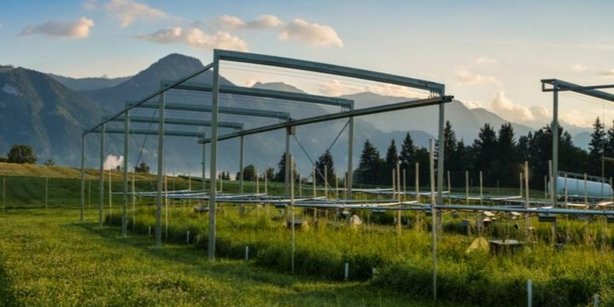ClimGrass C – Grassland carbon dynamics in a changing climate

Climate changes and elevated CO2 have major impacts on biogeochemical cycles, which may in turn feed back on the climate system. ClimGrass-C is a new…
☎ +43 1 4277 91263
✉ christina.kaiser(at)univie.ac.at
» CV
» u:cris
» u:find

Looking at soil from the perspective of complex systems science, Christina Kaiser’s group explores how small-scale microbial processes ultimately govern the composition and functioning of the community, and in turn, how this affects system processes like soil organic matter turnover. Her work combines soil microbial ecology and theoretical modelling with ecosystem biogeochemistry.
Christina’s group furthermore investigates carbon and nitrogen exchange in the tripartite symbiosis of plants, mycorrhizal fungi, and soil microbial decomposers. They combine state-of-the-art stable isotope techniques with nanoscale secondary ion mass spectrometry (NanoSIMS) to trace carbon and nitrogen through the plant-soil system, and to visualise elemental exchange at the plant-microbe interface, in situ and at subcellular scales. This allows deeper insights into the controls of this exchange and its consequences for ecosystem carbon and nitrogen cycling. Christina has received an ERC Consolidator grant to study self-organisation of microbial soil organic matter turnover.
Soil Microbial turnover of soil organic matter is responsible for the largest flux of C from land to the atmosphere. Its underlying mechanisms, however, are not fully understood, making it difficult to predict its response to environmental change. Microbial decomposition of organic matter requires the concerted action of functionally different microbes. In soil, a huge number of individual soil microbes and fauna interact with each other at the microscale within a dynamic system of pores and aggregates, feeding back on their community structure and physical environment. This makes soil a prime example for a complex system. From complex systems science, it is known that interactions among individuals at the microscale can lead to an ‘emergent’ system behavior at the macroscale. Such an emergent behavior, or self-organization, adds a new quality to the system which cannot be derived from the traits of the interacting individuals. Soil organic matter turnover is often investigated or modelled from an ‘aggregated’ view, measuring soil pools and processes in larger, homogenized soil samples, or using models based on aggregated, computable C pools. While this approach gives valuable information on the system’s state and behavior, it cannot easily reveal intrinsic mechanisms leading to emergent system behavior. Exploring the soil from the perspective of complex systems science opens up new possibilities to understand basic mechanisms within the soil microbial decomposer system, which complements other approaches. (picture on the right: soil bacteria colonising a root surface, made within the ROMY project at CIUS/University of Vienna)
In my group, we aim at developing tools, both theoretical and experimental, for investigating the soil system from the point of view of a “soil systems ecology”. Our approach recognizes the need to understand the interactions between individual agents in order to be able to predict the behaviour of the system, following the directive “the whole is something else than the sum of its parts” (Solé and Bascompte, “Self-Organization in complex ecosystems”, 2006). Our aim is to understand if and how mechanisms of microbial C and N cycling in the soil may depend on emergent properties driven by spatiotemporal dynamics of microbial communities and their substrates based on microbial microscale interactions.

One major interaction in soil is Mycorrhiza. Almost all land plants form this symbiosis, which is one of the oldest on earth (more than 400 Mio years). Mycorrhizal fungi help plants to scavenge for nutrients in the soil and are in turn provided with C by the plant. Due to their unique connection to plants, mycorrhizal fungi represent a major route for the input of plant-derived C to the soil. In addition, they may considerably contribute to microbial decomposition of organic matter, not only by excreting extracellular enzymes that target plant-derived organic polymers, but also by interacting with soil microbes (f.e. transferring plant C to soil bacteria, triggering a “priming effect”). Still, mycorrhizal fungi are not often considered in soil C and N turnover studies, particularly their interactions with soil bacteria have not received much attention so far. My group focuses on the mechanisms of C and N transfer between plant and mycorrhizal fungi, as well as between mycorrhizal fungi and soil bacteria and the effects of this tripartite partnership on the overall C and N turnover rates.
We use an individual-based, spatially-explicit microscale microbial C and N turnover model which I have developed, to simulate competitive and synergistic interactions between functionally different microbes in a spatially structured micro-scale environment. Based on this ‘bottom-up’ approach, we explore emergent behaviours of the decomposer system based on individual microbial traits.
My group uses stable-isotope labeling (based on EA-IRMS, GC-IRMS and GC-MS analyses), to trace the flow of plant-assimilated C, soil organic matter C, and soil-borne or amended N through the plant - soil - microbe system. Additionally, we use nano-scale secondary ion mass spectrometry (NanoSIMS) to visualize 13C and 15N flows directly across the plant-fungus interface in mycorrhizal roots, and – in collaboration with Dagmar Woebken’s group (DOME) - across the fungus-bacterial interface on mycorrhizal hyphae.
Investigating soil processes at the small scale in undisturbed soil samples is a challenge, but we are aiming towards that goal. We aim to develop methods to be able to analyse individual soil aggregates by using micro-sensors, adapting fluorimetric measurements of enzyme activities, using ultra sensitive HPLC methods, and NanoSIMS. In addition, we plan to extend our existing experience with measuring stable-isotopes (13C) in phospho-lipid fatty acids and microbial biomass, to other lipids and amino sugars, which are known biomarkers for fungi and for microbial necromass in the soil.


Climate changes and elevated CO2 have major impacts on biogeochemical cycles, which may in turn feed back on the climate system. ClimGrass-C is a new…

The Amazon rainforest stores large amounts of carbon in plant biomass and in soils, and is an important sink for atmospheric CO2 setting off increased…

Microbial turnover of soil organic matter (SOM) is key for the terrestrial carbon (C) cycle. Its underlying mechanisms, however, are not fully…
Kaiser C, Anthony MA. The role of ectomycorrhizal functional diversity in mediating soil carbon cycling under global change. New Phytologist. 2025 Sept 8. doi: 10.1111/nph.70559
Rasoulimehrabani H, Riva A, Inan D, Hodžić A, Hausmann B, Nikolov G et al. Lactulose selectively stimulates members of the gut microbiota, as determined by multi-modal activity-based sorting. Gut microbes. 2025 Jun 27;17(1):2525482. doi: 10.1080/19490976.2025.2525482
Wiesenbauer J, Gorka S, Jenab K, Schuster R, Kumar N, Rottensteiner C et al. Preferential use of organic acids over sugars by soil microbes in simulated root exudation. Soil Biology and Biochemistry. 2025 Feb 16;203:109738. doi: 10.1016/j.soilbio.2025.109738
Bunn RA, Corrêa A, Joshi J, Kaiser C, Lekberg Y, Prescott CE et al. What determines transfer of carbon from plants to mycorrhizal fungi? New Phytologist. 2024 Nov 1;244(4):1199-1215. doi: 10.1111/nph.20145
Guseva K, Mohrlok M, Alteio L, Schmidt H, Pollak S, Kaiser C. Bacteria face trade-offs in the decomposition of complex biopolymers. PLoS Computational Biology. 2024 Aug 8;20(8):e1012320. doi: 10.1371/journal.pcbi.1012320
Christina Kaiser is part of the FWF-funded Cluster of Excellence (CoE)

